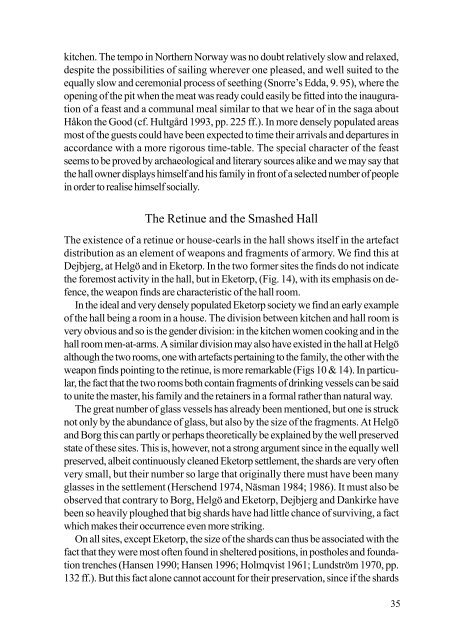Beowulf - Institutionen för arkeologi och antik historia
Beowulf - Institutionen för arkeologi och antik historia
Beowulf - Institutionen för arkeologi och antik historia
You also want an ePaper? Increase the reach of your titles
YUMPU automatically turns print PDFs into web optimized ePapers that Google loves.
kitchen. The tempo in Northern Norway was no doubt relatively slow and relaxed,<br />
despite the possibilities of sailing wherever one pleased, and well suited to the<br />
equally slow and ceremonial process of seething (Snorre’s Edda, 9. 95), where the<br />
opening of the pit when the meat was ready could easily be fitted into the inauguration<br />
of a feast and a communal meal similar to that we hear of in the saga about<br />
Håkon the Good (cf. Hultgård 1993, pp. 225 ff.). In more densely populated areas<br />
most of the guests could have been expected to time their arrivals and departures in<br />
accordance with a more rigorous time-table. The special character of the feast<br />
seems to be proved by archaeological and literary sources alike and we may say that<br />
the hall owner displays himself and his family in front of a selected number of people<br />
in order to realise himself socially.<br />
The Retinue and the Smashed Hall<br />
The existence of a retinue or house-cearls in the hall shows itself in the artefact<br />
distribution as an element of weapons and fragments of armory. We find this at<br />
Dejbjerg, at Helgö and in Eketorp. In the two former sites the finds do not indicate<br />
the foremost activity in the hall, but in Eketorp, (Fig. 14), with its emphasis on defence,<br />
the weapon finds are characteristic of the hall room.<br />
In the ideal and very densely populated Eketorp society we find an early example<br />
of the hall being a room in a house. The division between kitchen and hall room is<br />
very obvious and so is the gender division: in the kitchen women cooking and in the<br />
hall room men-at-arms. A similar division may also have existed in the hall at Helgö<br />
although the two rooms, one with artefacts pertaining to the family, the other with the<br />
weapon finds pointing to the retinue, is more remarkable (Figs 10 & 14). In particular,<br />
the fact that the two rooms both contain fragments of drinking vessels can be said<br />
to unite the master, his family and the retainers in a formal rather than natural way.<br />
The great number of glass vessels has already been mentioned, but one is struck<br />
not only by the abundance of glass, but also by the size of the fragments. At Helgö<br />
and Borg this can partly or perhaps theoretically be explained by the well preserved<br />
state of these sites. This is, however, not a strong argument since in the equally well<br />
preserved, albeit continuously cleaned Eketorp settlement, the shards are very often<br />
very small, but their number so large that originally there must have been many<br />
glasses in the settlement (Herschend 1974, Näsman 1984; 1986). It must also be<br />
observed that contrary to Borg, Helgö and Eketorp, Dejbjerg and Dankirke have<br />
been so heavily ploughed that big shards have had little chance of surviving, a fact<br />
which makes their occurrence even more striking.<br />
On all sites, except Eketorp, the size of the shards can thus be associated with the<br />
fact that they were most often found in sheltered positions, in postholes and foundation<br />
trenches (Hansen 1990; Hansen 1996; Holmqvist 1961; Lundström 1970, pp.<br />
132 ff.). But this fact alone cannot account for their preservation, since if the shards<br />
35








